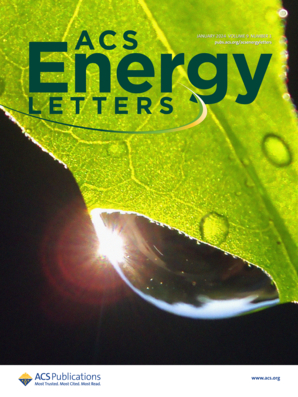Janus Solid Electrolyte with Ionic and Electronic Dual Conductive Face Guiding Lithium Deposition Oriental To Connect with Lithium Metal Anode
IF 19.3
1区 材料科学
Q1 CHEMISTRY, PHYSICAL
引用次数: 0
Abstract
Polymer solid electrolytes show facile flexibility and processability, but the trade-off between ionic conductivity and lithium dendrite inhibition ability restricts their practical applications. Herein, polyacrylonitrile (PAN)/carbon nanotube (CNT) with one face electronic conductive membrane is merged with in situ polymerized ionic conductive polyethylene glycol diacrylate (PEGDA)/ethylene carbonate (EC)/dimethylcarbamide (DMC)/lithium bistrifluoromethane sulfonimide (LiTFSI) to construct Janus solid electrolyte PAN/CNT@PEDL. The ionic conductive face of PAN@PEDL is responsible for transporting Li+ and separating the cathode/anode. The other face of PAN-CNT@PEDL with ionic and electronic conductive peculiarity transports Li+ and electrons simultaneously, guiding Li+ deposition oriental in it and its interface connecting with the Li anode rather than puncturing electrolyte. The Janus solid electrolyte holds a high ionic conductivity of 3.48 mS cm–1 at 30 °C and orientated Li+ deposition ability. Both Li||Li and LiFePO4(LFP)||Li cells show improved cycling performances. The concept of Janus ionic/ionic and electronic conductive solid electrolytes proposes a new perspective for designing solid electrolytes.

Janus固体电解质离子和电子双导电面引导锂沉积东方连接锂金属阳极
聚合物固体电解质具有良好的柔韧性和可加工性,但离子电导率和锂枝晶抑制能力之间的权衡限制了其实际应用。本文将具有单面电子导电膜的聚丙烯腈(PAN)/碳纳米管(CNT)与原位聚合离子导电聚乙二醇二丙烯酸酯(PEGDA)/碳酸乙烯(EC)/二甲脲(DMC)/双三氟甲烷磺酰亚胺锂(LiTFSI)合并,构建Janus固体电解质PAN/CNT@PEDL。PAN@PEDL的离子导电面负责传递Li+和分离阴极/阳极。PAN-CNT@PEDL的另一面具有离子和电子导电特性,同时传输Li+和电子,引导Li+在其中向东沉积,其界面与Li阳极连接而不是刺穿电解质。Janus固体电解质在30°C时具有3.48 mS cm-1的高离子电导率和定向Li+沉积能力。锂离子电池||锂离子电池和LiFePO4(LFP)||锂离子电池均表现出较好的循环性能。Janus离子/离子和电子导电固体电解质的概念为固体电解质的设计提供了一个新的视角。
本文章由计算机程序翻译,如有差异,请以英文原文为准。
求助全文
约1分钟内获得全文
求助全文
来源期刊

ACS Energy Letters
Energy-Renewable Energy, Sustainability and the Environment
CiteScore
31.20
自引率
5.00%
发文量
469
审稿时长
1 months
期刊介绍:
ACS Energy Letters is a monthly journal that publishes papers reporting new scientific advances in energy research. The journal focuses on topics that are of interest to scientists working in the fundamental and applied sciences. Rapid publication is a central criterion for acceptance, and the journal is known for its quick publication times, with an average of 4-6 weeks from submission to web publication in As Soon As Publishable format.
ACS Energy Letters is ranked as the number one journal in the Web of Science Electrochemistry category. It also ranks within the top 10 journals for Physical Chemistry, Energy & Fuels, and Nanoscience & Nanotechnology.
The journal offers several types of articles, including Letters, Energy Express, Perspectives, Reviews, Editorials, Viewpoints and Energy Focus. Additionally, authors have the option to submit videos that summarize or support the information presented in a Perspective or Review article, which can be highlighted on the journal's website. ACS Energy Letters is abstracted and indexed in Chemical Abstracts Service/SciFinder, EBSCO-summon, PubMed, Web of Science, Scopus and Portico.
 求助内容:
求助内容: 应助结果提醒方式:
应助结果提醒方式:


